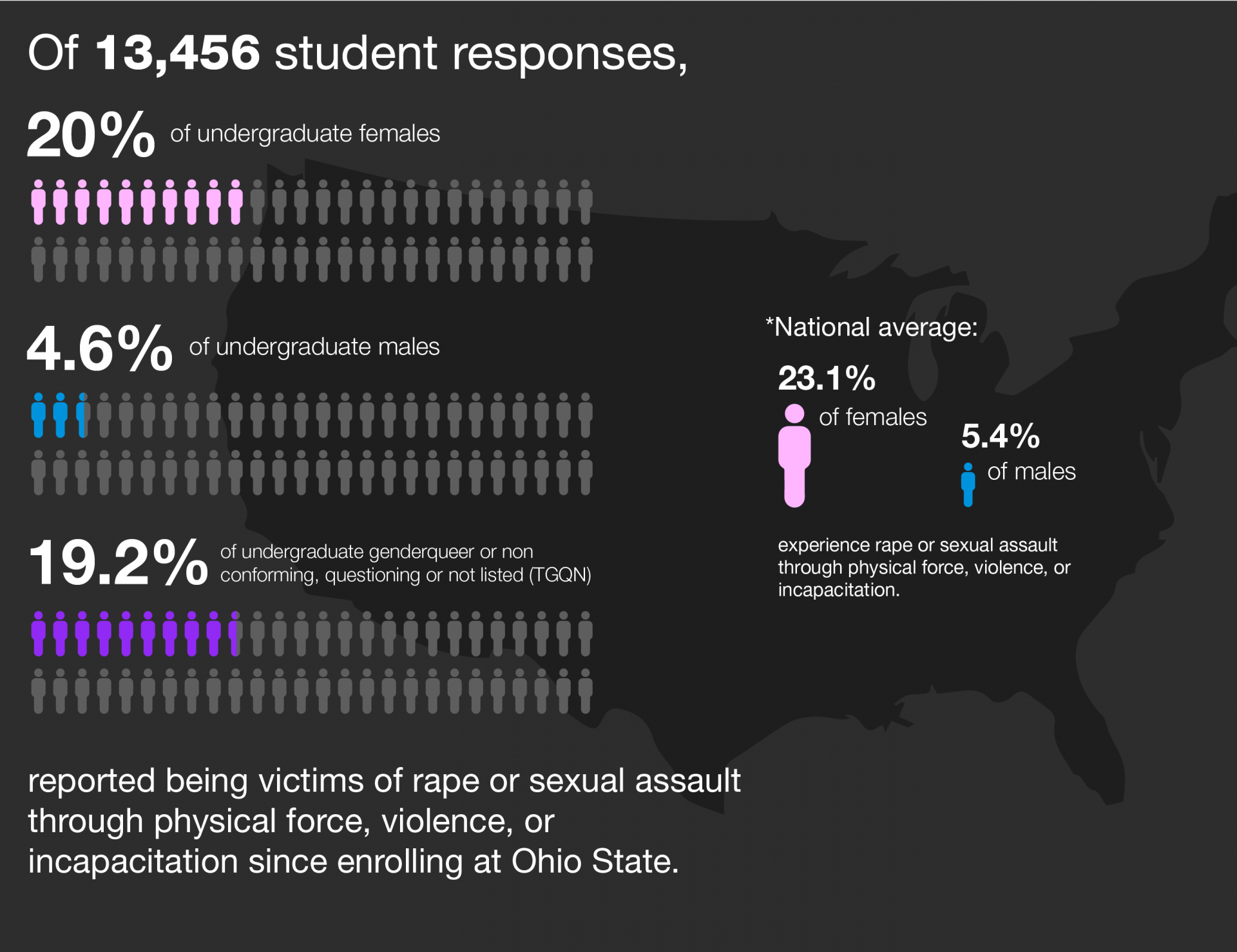For the second year in a row, one in five undergraduate female respondents to Ohio State’s campus climate survey reported being victim to nonconsensual sexual intercourse or touching by force, threats of physical force or incapacitation.
The third annual survey, released Wednesday, recorded 13,456 student responses. Of those who responded, 20 percent of undergraduate females, 4.6 percent of undergraduate males and 19.2 percent of undergraduate genderqueer or nonconforming, questioning or not listed (TGQN) students reported being victims of nonconsensual sexual intercourse or sexual touching by physical force, threats of physical force or incapacitation since enrolling at Ohio State.
In 2016, 20.6 percent of the female undergraduate students who responded said they had been victims of nonconsensual sexual contact by physical force or while they were incapacitated, which was a slight improvement from the 2015 survey at 24 percent.
This year, 12.2 percent of female, 2.9 percent of male and 13.1 TGQN undergraduate respondents said they were victims of sexual assault involving physical force or incapacitation since enrolling at Ohio State.
The 2017 Campus Climate Survey was sent to 63,587 Ohio State students and had a 21.2 percent response rate. The goal of the survey is to provide data to guide action on Ohio State’s campus around the issue of sexual misconduct and relationship violence. Of those who responded, 94.7 percent attended the Columbus campus and 78.1 percent of respondents were undergraduate students.
“The data will also be used to take action to enhance current policies and procedures, as well as do more detailed analysis, and get feedback from the university community, to inform longer-term strategies and programs,” Ohio State spokesman Ben Johnson said in an email. “Examples include: continued importance of education about consent, unique needs of specific student populations.”
The 2016 survey was sent to 62,291 students, and the university received a 21.1 percent response rate of 13,152 responses.
Eighteen percent of respondents said sexual assault or sexual misconduct is very or extremely prevalent at Ohio State; 41.8 percent said it is not at all or a little and 40.3 percent said it is somewhat prevalent.
Seventy-nine percent of respondents said it is not at all or a “little likely” that they will experience sexual assault or misconduct on campus; 5.6 percent report it is “very” or “extremely likely.”
In 2016, 6.4 percent of the student respondents said it was likely they would fall victim to sexual misconduct or sexual assault while on campus.
Seventy percent of respondents said it is very or extremely likely that a report of sexual assault or misconduct would be taken seriously by officials; 9.4 percent said it is not at all or a little likely to be taken seriously. Nearly 68 percent of respondents said it is very or extremely likely that the safety of those reporting an incident of sexual assault of misconduct would be protected by university officials.
In 2016, 62 percent of respondents reported that it would be likely that their safety would be protected by campus officials if they were to report an incident of sexual assault or sexual misconduct; 67 percent reported that it would be taken seriously by campus officials.
Relationship violence involving Ohio State community members
Nearly 13 percent of respondents reported experiencing at least one form of intimate partner violence, such as kicking, punching, pushing, hitting or slapping; 5.5 percent reported experiencing this form of violence during the past school year.
TGQN respondents were more likely to experience intimate partner violence since enrolling at Ohio State; 20.4 percent of TGQN students reported an incident of violence they experienced.
Eighty-two percent of intimate partner violence respondents did not report the violence to a university program; 57.8 percent of those did not contact a program because they did not think the violence was serious enough to report.
Campus harassment
Inappropriate or offensive comments made to or witnessed by students was the most frequently reported form of harassment perpetrated by someone at Ohio State — 36.2 percent of respondents reported this form of harassment — the least reported harassment, reported by 7.5 percent of respondents, was someone sending offensive remarks, videos, pictures, et cetera electronically.
Per the report’s methodology, sexual misconduct is used to refer to conduct of a sexual nature based on sex or gender that is nonconsensual or has the effect of threatening, intimidating or coercing a person. Sexual assault refers to specific incidents of nonconsensual sexual intercourse, including penetration or oral sex and nonconsensual sexual touching.



